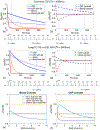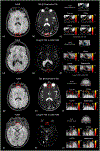Concurrent measurement of perfusion parameters related to small blood vessels and cerebrospinal fluid circulation in the human brain using dynamic dual-spin-echo perfusion MRI
- PMID: 37308297
- PMCID: PMC10808973
- DOI: 10.1002/nbm.4984
Concurrent measurement of perfusion parameters related to small blood vessels and cerebrospinal fluid circulation in the human brain using dynamic dual-spin-echo perfusion MRI
Abstract
Accumulating evidence from recent studies has indicated the importance of studying the interaction between the microvascular and lymphatic systems in the brain. To date, most imaging methods can only measure blood or lymphatic vessels separately, such as dynamic susceptibility contrast (DSC) MRI for blood vessels and DSC MRI-in-the-cerebrospinal fluid (CSF) (cDSC MRI) for lymphatic vessels. An approach that can measure both blood and lymphatic vessels in a single scan offers advantages such as a halved scan time and contrast dosage. This study attempts to develop one such approach by optimizing a dual-echo turbo-spin-echo sequence, termed "dynamic dual-spin-echo perfusion (DDSEP) MRI". Bloch simulations were performed to optimize the dual-echo sequence for the measurement of gadolinium (Gd)-induced blood and CSF signal changes using a short and a long echo time, respectively. The proposed method furnishes a T1-dominant contrast in CSF and a T2-dominant contrast in blood. MRI experiments were performed in healthy subjects to evaluate the dual-echo approach by comparing it with existing separate methods. Based on simulations, the short and long echo time were chosen around the time when blood signals show maximum difference between post- and pre-Gd scans, and the time when blood signals are completely suppressed, respectively. The proposed method showed consistent results in human brains as previous studies using separate methods. Signal changes from small blood vessels occurred faster than from lymphatic vessels after intravenous Gd injection. In conclusion, Gd-induced signal changes in blood and CSF can be detected simultaneously in healthy subjects with the proposed sequence. The temporal difference in Gd-induced signal changes from small blood and lymphatic vessels after intravenous Gd injection was confirmed using the proposed approach in the same human subjects. Results from this proof-of-concept study will be used to further optimize DDSEP MRI in subsequent studies.
Keywords: DCE; DSC; ISF; contrast; gadolinium; lymphatic.
© 2023 John Wiley & Sons Ltd.
Figures




Similar articles
-
Fast whole brain MR imaging of dynamic susceptibility contrast changes in the cerebrospinal fluid (cDSC MRI).Magn Reson Med. 2020 Dec;84(6):3256-3270. doi: 10.1002/mrm.28389. Epub 2020 Jul 3. Magn Reson Med. 2020. PMID: 32621291 Free PMC article.
-
Differentiation of breast cancer from fibroadenoma with dual-echo dynamic contrast-enhanced MRI.PLoS One. 2013 Jul 2;8(7):e67731. doi: 10.1371/journal.pone.0067731. Print 2013. PLoS One. 2013. PMID: 23844077 Free PMC article.
-
Gadolinium Presence in the Brain After Administration of the Liver-Specific Gadolinium-Based Contrast Agent Gadoxetate: A Systematic Comparison to Multipurpose Agents in Rats.Invest Radiol. 2019 Aug;54(8):468-474. doi: 10.1097/RLI.0000000000000559. Invest Radiol. 2019. PMID: 30932931
-
Semiquantitative 3T Brain Magnetic Resonance Imaging for Dynamic Visualization of the Glymphatic-Lymphatic Fluid Transport System in Humans: A Pilot Study.Invest Radiol. 2022 Aug 1;57(8):544-551. doi: 10.1097/RLI.0000000000000870. Epub 2022 Apr 1. Invest Radiol. 2022. PMID: 35763443
-
Imaging vascular and hemodynamic features of the brain using dynamic susceptibility contrast and dynamic contrast enhanced MRI.Neuroimage. 2019 Feb 15;187:32-55. doi: 10.1016/j.neuroimage.2018.04.069. Epub 2018 May 3. Neuroimage. 2019. PMID: 29729392 Free PMC article.
Cited by
-
Exploring neurodegenerative disorders using advanced magnetic resonance imaging of the glymphatic system.Front Psychiatry. 2024 Apr 8;15:1368489. doi: 10.3389/fpsyt.2024.1368489. eCollection 2024. Front Psychiatry. 2024. PMID: 38651012 Free PMC article. Review.
-
Diffusion magnetic resonance imaging of cerebrospinal fluid dynamics: Current techniques and future advancements.NMR Biomed. 2024 Sep;37(9):e5162. doi: 10.1002/nbm.5162. Epub 2024 May 7. NMR Biomed. 2024. PMID: 38715420 Free PMC article. Review.
-
Neurofluids and the glymphatic system: anatomy, physiology, and imaging.Br J Radiol. 2023 Nov;96(1151):20230016. doi: 10.1259/bjr.20230016. Epub 2023 Jun 1. Br J Radiol. 2023. PMID: 37191063 Free PMC article. Review.
-
The glymphatic system in Huntington's disease.J Huntingtons Dis. 2025 Aug;14(3):279-290. doi: 10.1177/18796397251331436. Epub 2025 Mar 28. J Huntingtons Dis. 2025. PMID: 40152274 Free PMC article. Review.
References
Publication types
MeSH terms
Substances
Grants and funding
LinkOut - more resources
Full Text Sources
Medical

